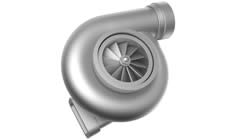How A Turbocharger Helps Increase Engine Power - Vol.176
When it comes to increasing the power output of a car's engine, helping to create a more air-enriched environment within the compression cylinders will help the engine burn more fuel more efficiently. Anytime that more fuel can be burned by the engine will result in an increase in the power produced by the engine. For these reasons, increasing the air pumped into an engine is known as "charging" the engine.

Devices that operate solely with the purpose of increasing the amount of air being compressed into the cylinders are known as chargers, and they come in two varieties: turbochargers and superchargers. Turbocharging an engine is slightly different from supercharging an engine. In a supercharger, the air compression is performed by a device that is driven by the mechanical components of the engine. In a turbocharger, the air compression is done by an air compressor that is powered by a turbine that uses the engine's exhaust to drive its actions. A device that combines both a supercharger and a turbocharger is known as a "twincharger."
As mentioned before, turbochargers help to increase the power output of an engine by forcing more air into the compression chambers within a cylinder in an internal combustion engine. An increase in air added to the system also increases the amount of oxygen present within the chamber. With more oxygen present, the engine can not only burn more fuel but it can also burn that fuel more efficiently. The net result is that a turbocharger will increase both the power and the fuel efficiency of a car's engine.
How much power output is gained from the increase in air pressure depends largely on the altitude at which the automobile is driven. At sea level, the air pressure is measured at 14.7 pounds per square inch (psi); that is to say that the column of air pressing down on one square inch of the surface of the Earth weighs about 14.7 pounds. As the altitude increases, there is less air pressing down on the surface, which means that the air pressure is less at higher elevations.
Depending on the brand, a driver can expect a turbocharger to increase the air pressure within a cylinder anywhere from six to eight psi, or roughly by half. In a perfect world, this would correlate to an efficiency rating of 150%, but no engines operate at full efficiency. Some of the energy is lost as heat, some of the fuel can leak out, or a whole host of other issues can cause loss of work efficiency in an engine. The inclusion of a turbocharger will help the engine work anywhere between thirty and forty percent increased efficiency.
This can be especially important or helpful for engines that typically operate at higher elevations. As mentioned previously, the higher the altitude, the lower the air pressure. A turbocharger can help to increase the power output of an engine so that it works as well as a non-turbocharged engine at lower elevations. Especially for vehicles that need additional power for hauling or towing at higher elevations, a turbocharger can be a very helpful tool for increasing power and efficiency for these overworked engines. Not only will the power and the efficiency be increased, but the lifespan of the engine could be lengthened.
One thing to remember with a turbocharger is that it uses the exhaust from the engine to help drive the turbine. The air coming out of an engine is already hot from being compressed and burned. Turbochargers, while helpful devices, can also lead to knocking in the engine--this is when the air temperature within the cylinder is hot enough to ignite the air and fuel mixture before the sparkplug can ignite it. One way of combating this is to burn higher octane fuel.